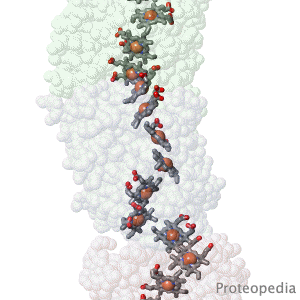Proteopedia:Featured JRN/3: Difference between revisions
Eric Martz (talk | contribs) New page: <table> <tr><td> <imagemap> Image:Featured-omcs-6ef8.gif|center default Malvankar Lab: Structure of Microbial Nanowires </imagemap> </td></tr... |
m Protected "Proteopedia:Featured JRN/3" [edit=sysop:move=sysop] |
||
| (4 intermediate revisions by one other user not shown) | |||
| Line 3: | Line 3: | ||
<imagemap> | <imagemap> | ||
Image:Featured-omcs-6ef8.gif|center | Image:Featured-omcs-6ef8.gif|center | ||
default [[User:Nikhil Malvankar/Cytochrome nanowires | default [[User:Nikhil Malvankar/Cytochrome nanowires]] | ||
</imagemap> | </imagemap> | ||
</td></tr> | </td></tr> | ||
<tr><td><div class="scrolling">'''Geobacter nanowire structure surprise.'''<br> | <tr><td><div class="scrolling">'''Geobacter nanowire structure surprise.'''<br> | ||
''F Wang, Y Gu, JP O'Brien, SM Yi, SE Yalcin, V Srikanth, C Shen, D Vu, NL Ing, AI Hochbaum, EH Egelman, NS Malvankar''. Cell 2019 doi: [http://doi.org/10.1016/j.cell.2019.03.029 10.1016/j.cell.2019.03.029]<br>Bacteria living in anaerobic environments (no oxygen) need alternative electron acceptors in order to get energy from their food. An acceptor abundant in the earth's crust is red iron oxide ("rust"), which gets reduced to black iron oxide (magnetite). Many bacteria, such as Geobacter, | ''F Wang, Y Gu, JP O'Brien, SM Yi, SE Yalcin, V Srikanth, C Shen, D Vu, NL Ing, AI Hochbaum, EH Egelman, NS Malvankar''. Cell 2019 doi: [http://doi.org/10.1016/j.cell.2019.03.029 10.1016/j.cell.2019.03.029]<br>Bacteria living in anaerobic environments (no oxygen) need alternative electron acceptors in order to get energy from their food. An acceptor abundant in the earth's crust is red iron oxide ("rust"), which gets reduced to black iron oxide (magnetite). Many bacteria, such as Geobacter, get their metabolic energy by transferring electrons to acceptors that are multiple cell diameters distant, using protein nanowires. These were long thought to be pili. But when the structure of the nanowires was solved in 2019, to everyone's surprise, they turned out to be unprecedented linear polymers of multi-heme cytochromes. The hemes form an electrically conductive chain in the cores of these nanowires. | ||
>>> [[ | >>> [[Malvankar/2|Visit I3DC Interactive Visualizations]] >>> | ||
</div> | </div> | ||
</td></tr> | </td></tr> | ||
Latest revision as of 04:51, 7 November 2022
 |
Geobacter nanowire structure surprise.
F Wang, Y Gu, JP O'Brien, SM Yi, SE Yalcin, V Srikanth, C Shen, D Vu, NL Ing, AI Hochbaum, EH Egelman, NS Malvankar. Cell 2019 doi: 10.1016/j.cell.2019.03.029 |